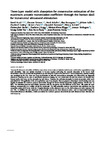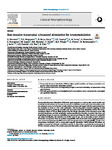Three-layer model with absorption for conservative estimation of the maximum acoustic transmission coefficient through the human skull for transcranial ultrasound stimulation
| dc.contributor.author | Attali, D | |
| dc.contributor.author | Tiennot, T | |
| dc.contributor.author | Schafer, M | |
| dc.contributor.author | Fouragnan, Elsa | |
| dc.contributor.author | Sallet, J | |
| dc.contributor.author | Caskey, C | |
| dc.contributor.author | Chen, R | |
| dc.contributor.author | Darmani, G | |
| dc.contributor.author | Bubrick, EJ | |
| dc.contributor.author | Butler, C | |
| dc.contributor.author | Stagg, C | |
| dc.contributor.author | Klein-Flügge, M | |
| dc.contributor.author | Verhagen, L | |
| dc.contributor.author | Yoo, S-S | |
| dc.contributor.author | Pauly, KB | |
| dc.contributor.author | Aubry, J-F | |
| dc.date.accessioned | 2023-01-21T21:29:23Z | |
| dc.date.issued | 2023-01 | |
| dc.identifier.issn | 1935-861X | |
| dc.identifier.issn | 1876-4754 | |
| dc.identifier.uri | http://hdl.handle.net/10026.1/20189 | |
| dc.description.abstract |
Transcranial ultrasound stimulation (TUS) has been shown to be a safe and effective technique for non-invasive superficial and deep brain stimulation. Safe and efficient translation to humans requires estimating the acoustic attenuation of the human skull. Nevertheless, there are no international guidelines for estimating the impact of the skull bone. A tissue independent, arbitrary derating was developed by the U.S. Food and Drug Administration to take into account tissue absorption (0.3 dB/cm-MHz) for diagnostic ultrasound. However, for the case of transcranial ultrasound imaging, the FDA model does not take into account the insertion loss induced by the skull bone, nor the absorption by brain tissue. Therefore, the estimated absorption is overly conservative which could potentially limit TUS applications if the same guidelines were to be adopted. Here we propose a three-layer model including bone absorption to calculate the maximum pressure transmission through the human skull for frequencies ranging between 100 kHz and 1.5 MHz. The calculated pressure transmission decreases with the frequency and the thickness of the bone, with peaks for each thickness corresponding to a multiple of half the wavelength. The 95th percentile maximum transmission was calculated over the accessible surface of 20 human skulls for 12 typical diameters of the ultrasound beam on the skull surface, and varies between 40% and 78%. To facilitate the safe adjustment of the acoustic pressure for short ultrasound pulses, such as transcranial imaging or transcranial ultrasound stimulation, a table summarizes the maximum pressure transmission for each ultrasound beam diameter and each frequency. | |
| dc.format.extent | 48-55 | |
| dc.format.medium | Print-Electronic | |
| dc.language | en | |
| dc.language.iso | eng | |
| dc.publisher | Elsevier BV | |
| dc.rights | Attribution-ShareAlike 4.0 International | |
| dc.rights.uri | http://creativecommons.org/licenses/by-sa/4.0/ | |
| dc.subject | Focused ultrasound neuromodulation (FUN) | |
| dc.subject | Low-intensity focused ultrasound (LIFUS) | |
| dc.subject | Transcranial focused ultrasound (tFUS) | |
| dc.subject | Transcranial pulsed ultrasound (TPS) | |
| dc.subject | Transcranial ultrasound stimulation (TUS) | |
| dc.subject | Ultrasonic neuromodulation (UNMOD) | |
| dc.subject | Humans | |
| dc.subject | Skull | |
| dc.subject | Ultrasonography | |
| dc.subject | Brain | |
| dc.subject | Acoustics | |
| dc.subject | Head | |
| dc.title | Three-layer model with absorption for conservative estimation of the maximum acoustic transmission coefficient through the human skull for transcranial ultrasound stimulation | |
| dc.type | journal-article | |
| dc.type | Journal Article | |
| dc.type | Research Support, Non-U.S. Gov't | |
| plymouth.author-url | https://www.ncbi.nlm.nih.gov/pubmed/36549480 | |
| plymouth.issue | 1 | |
| plymouth.volume | 16 | |
| plymouth.publication-status | Published | |
| plymouth.journal | Brain Stimulation | |
| dc.identifier.doi | 10.1016/j.brs.2022.12.005 | |
| plymouth.organisational-group | /Plymouth | |
| plymouth.organisational-group | /Plymouth/Faculty of Health | |
| plymouth.organisational-group | /Plymouth/Faculty of Health/School of Psychology | |
| plymouth.organisational-group | /Plymouth/REF 2021 Researchers by UoA | |
| plymouth.organisational-group | /Plymouth/REF 2021 Researchers by UoA/UoA04 Psychology, Psychiatry and Neuroscience | |
| plymouth.organisational-group | /Plymouth/Users by role | |
| plymouth.organisational-group | /Plymouth/Users by role/Academics | |
| plymouth.organisational-group | /Plymouth/Users by role/Researchers in ResearchFish submission | |
| dc.publisher.place | United States | |
| dcterms.dateAccepted | 2022-12-12 | |
| dc.rights.embargodate | 2023-1-25 | |
| dc.identifier.eissn | 1876-4754 | |
| rioxxterms.funder | Medical Research Council | |
| rioxxterms.identifier.project | Mapping the neural basis of credit assignment for a new targeted intervention in addiction | |
| rioxxterms.versionofrecord | 10.1016/j.brs.2022.12.005 | |
| rioxxterms.licenseref.uri | http://creativecommons.org/licenses/by-sa/4.0/ | |
| rioxxterms.licenseref.startdate | 2022-12-19 | |
| rioxxterms.type | Journal Article/Review | |
| plymouth.funder | Mapping the neural basis of credit assignment for a new targeted intervention in addiction::Medical Research Council |




